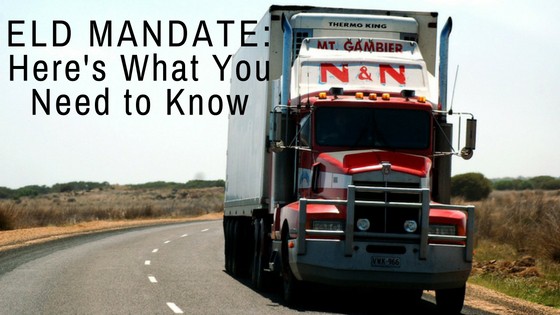Electronic Logging Devices (ELD) will be mandatory for most carriers and drivers to have installed by December 16, 2019. For those who are unsure what an ELD is, it’s a device that will synchronize with a vehicle’s engine to automatically record driving time. This will provide more accurate hours of service and element the need for drivers to maintain paper logs; although, supporting documentation will be required to be submitted to their carrier or to owner-operators keep on file (more on this later). If you would like to read the full ELD mandate rules here it is, but beware it’s quite lengthy (126 pages!): https://www.gpo.gov/fdsys/pkg/FR-2015-12-16/pdf/2015-31336.pdf
For those that don’t have the time to read the full mandate (we do suggest you do at some point), here’s what you need to know to make sure your fleet is ELD compliant before December 2017:
- The ELD mandate will apply to any driver required to keep a record of duty status (RODS). However, there are exceptions. Those who are exempt are:
- Drivers who keep RODS no more than 8 days during any 30-day period;
- Drive away-tow away drivers (transporting an empty vehicle for sale, lease, or repair), provided that the vehicle driven is part of the shipment; or,
- Drivers of vehicles manufactured before model year 2000.
- An electronic logging device (ELD) is not the same as an automatic onboard recording device; so please don’t confuse the two. Be sure that you get a FMCSA approved ELD. Here’s a lists of certified and registeried ELD manufactures: https://3pdp.fmcsa.dot.gov/ELD/ELDList.aspx
- As mentioned earlier, supporting documentation will be required to keep on file. So what is considered supporting documentation?
- Bills of lading, itineraries, schedules, or equivalent documents that show the starting and ending location for each trip;
- Dispatch records, trip records, or equivalent documents;
- Expense receipts (meals, lodging, fuel, etc.);
- Fleet management system communication records;
- Payroll records, settlement sheets, or equivalent documents showing the driver was paid.
The implementation of this rule will happen in 3 phases:
Phase 1: Awareness and Transition Phase The two-year period following publication of the ELD rule February 16, 2016 to December 18, 2017. During this time, carriers and drivers subject to the rule should prepare to comply, and may voluntarily use ELDs.
Carriers and drivers subject to the rule can use any of the following for records of duty status (RODS):
- Paper logs
- Logging software
- AOBRDS (Automatic On Board Recording Devices)
- ELDs that are registered and listed on the FMCSA website
Phase 2: Phased-In Compliance Phase The two-year period from the Compliance Date to the Full Compliance Phase (December 18, 2017 to December 16, 2019). Carriers and drivers subject to the rule can use:
- AOBRDS that were installed prior to December 18, 2017.
- Certified, registered ELDs following rule publication December 16, 2015.
Phase 3: Full Compliance Phase After December 16, 2019 all drivers and carriers subject to the rule must use certified, registered ELDs that comply with requirements of the ELD regulations.
There’s a lot more to know, so be sure visit the Federal Motor Carrier Safety Administration’s for a full understanding of the ELD rules so that you can be ready and compliant by December 16, 2017.
Sources: https://www.fmcsa.dot.gov/hours-service/elds/electronic-logging-devices

